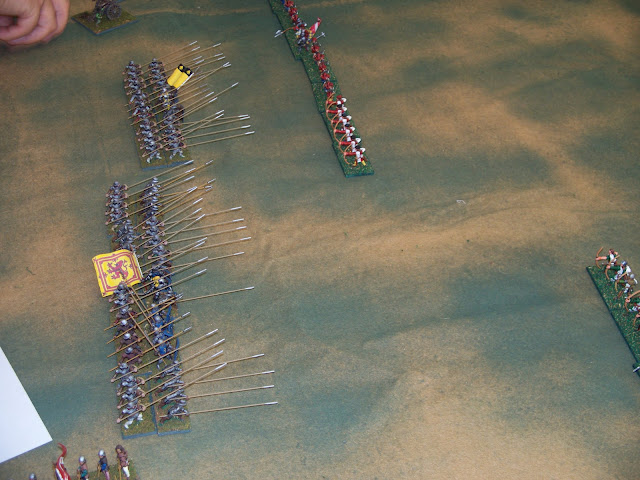https://drive.google.com/file/d/0B0-_LMmXX3FSb2pFdU1FZlU3YlU/view?usp=sharing
Our buddy Jeff modified the Lace Wars rules for some 15mm Grand scale Napoleonic games that we had. The intent was that rules should be easy to learn and play, with a historical feel. We had several enjoyable games with these rules using lots of troops, and the games usually ended within 4 hours or so. Uncle Duke liked the game so much, he called them the best Napoleonic rules he had ever played, which was certainly high praise. However, Uncle Duke then toyed around with the rules and developed his own, much more detailed version, or UDN. Duke's 15mm Napoleonic figures were from his own line of Heritage Napoleonic Miniatures called Napoleonettes, hence the name Napoleonette in UDN. Below are some photos of our pre-publication play test game. Finally, I thought it would be good to prove that someone actually played these rules.
The game was played on Uncle Duke's famous 2' x 2' terrain squares on a 12' x 6' table. The Bavarian town of Krankenstaadt in the background. Click on the photos to enlarge.
French commanders Prince Pavlik of the Grand Duchy of Warsaw (actually Mr. Bob on the left) and Marshall Jeffrie (Jeff on the right) and your's truely. The troops operated in large regimental units with bases holding many miniatures. We use Uncle Duke's famous movement sticks, which are more fun to use than rulers.
Marshall Jeffrie is taunting the Austrians, explaining why they are inferior to the French. Uncle Duke (right) looks downcast & pondering what will happen next, since he has Austrian heritage.
Hapsburg Archdukes William (Mr. Bill to the left) and Allen (Al to the right) commanded the inferior Austrians.
Uncle Duke observes Archdukes William and Allen moving their inferior Austrians forward. Archduke Allen is trying hard to stay awake after a night of partying in Vienna.
Marshall Jeffrie is admiring his troops and grinning over the impending victory, as they advance towards the hapless Austrians.
A panorama of the battle of Krankenstaadt. I thought the best thing about this game was how the troops looked.
A division of inferior Austrian infantry advancing.
Another view of the battle from the opposite side of the table. Note that each regiment has name labels and organizational information on the back of each unit.
Prince Pavlik observes Archduke Allen rolling dice to ensure he doesn't re-roll the results he doesn't like. Archduke Allen's cavalry was decimated by Prince Pavlik's troops, however the Austrian cavalry under Archduke William made very un-Austrian like manoevers on the French left, which you can just see on the lower right of the photo.
Inferior Austrian Grenzer Infantry.
Inferior Hungarian infantry deploying into line formation from thier regimental bases, supported by brown coated inferior Austrian artillery. Austrian artillery uniforms were obviously easier to keep clean than infantry uniforms.
Another overview of the battle of Krankenstaadt. Note that the French left flank (lower right in the photo) is turned in from inferior Austrian cavalry attacks.
The final photo of the battle, with Archduke William now moving his troops around the French left flank. How could the inferior Austrians do this to the French? Probably bad die rolling. Archduke Allen and Prince Pavlik have fought to a draw on the other flank.
Another overview of the battle of Krankenstaadt. Note that the French left flank (lower right in the photo) is turned in from inferior Austrian cavalry attacks.
The final photo of the battle, with Archduke William now moving his troops around the French left flank. How could the inferior Austrians do this to the French? Probably bad die rolling. Archduke Allen and Prince Pavlik have fought to a draw on the other flank.






















